!['The bee directs the works [iw bi.t xrp=s kA.wt].' Adapted from text in the Assimil course, formatted with JSesh. Hieroglyphics with an Infinibee](http://blog.beeminder.com/wp-content/uploads/2014/05/hiero1.png)
We were (and are) pretty pleased with our Duolingo integration but in this guest post, software developer and language-learning expert [1] Eric Kidd puts that to shame. It’s seriously impressive. (If you’re a programmer we also highly recommend Eric’s blog, Random Hacks.)
I learned to speak French in my 30s. [2] It turns out that learning a language is a bit like hiking all 2,200 miles of the Appalacian trial: it sounds like something that only a talented elite could do. But all you really need is the ability to keep putting one foot in front of another for 6 or 7 months. Couch potatoes have hiked the trail — as well as a grandmother in sneakers with a homemade bag slung over her shoulder. Language learning is the same way: If you can stick with it long enough, you’ll get there. Sheer stubborn persistence is a superpower.
Now, when I learned French, I had the luxury of being totally committed. I spoke it with my wife. I read 500 pages of French a month for 20 months. I bought the French dubs of Buffy the Vampire Slayer [3] and Angel and watched season after season. It was easy for me to stay motivated, because I was obsessed.
But when I decided to learn Egyptian, I was faced with a dilemma: I couldn’t justify spending more than an hour per week on it. Hierogylphs are cool, but come on — it’s a dead language. Unfortunately, it’s hard to learn a language in slow motion, because two things always go wrong:
- I get distracted, and I never actually put in that hour per week. You’re reading this on the Beeminder blog, so you can already guess how I’m handling this.
- I forget everything I learn between lessons. Fortunately, I already knew about spaced repetition and the awesome memory amplifier provided by Anki.
So how does this work in practice?
Picking a course and setting a goal
My favorite language courses are made by Assimil, a family-owned French company. These courses are great for beeminding, because each lesson takes 20 to 40 minutes, and I can mostly just soak up the language through osmosis. Assimil publishes quite a few language courses for English speakers, but in this case, I grabbed L’Égyptien hiéroglyphique out of their French catalog. [4] The English version of this course isn’t expected to come out before 2015, and I wanted an excuse to practice my French.
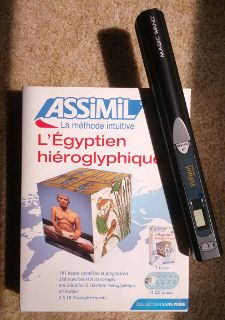
Normally, I’d study one Assimil lesson per day. But this time, my goal is to study one lesson per week:
Beeminder is in charge of letting me know when I’m in danger of dropping below my goal. I find this enormously helpful, because at a rate of one lesson per week, I have no intrinsic momentum or habits to keep me going.
Anki, the memory amplifier
Anki is my favorite flashcard software. It implements spaced repetition, which means that I don’t have to waste any more time than necessary on a given card. There’s an open source desktop version, a slightly pricey iPhone app, and an open source app for Android users. Anki supports robust syncing, plugins, images and audio. Using Anki, I have few problems remembering what I’ve learned between lessons.
Since I’m lazy, and I refuse to waste any time on data entry, I’m using images of the pages. You can make these using a cell phone camera or a scanner wand. Of course, it would be ideal if I could buy a PDF of my language course and just copy and paste.
Once I have an image, I paste a section of the Assimil lesson into an image editor:
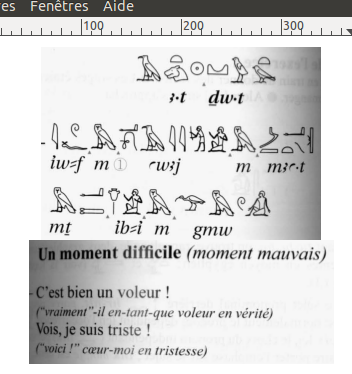
This comes from a short story about a light-fingered monkey that steals a girl’s necklace. In English, it would read:
A difficult moment (bad moment)
It really is a thief.
(“Truly”-he as-a thief in truth)
Look, I’m sad!
(Look, heart-me in sadness)
Once I’ve assembled the image, I open the Anki Image Occlusion Plugin, and paste it in:
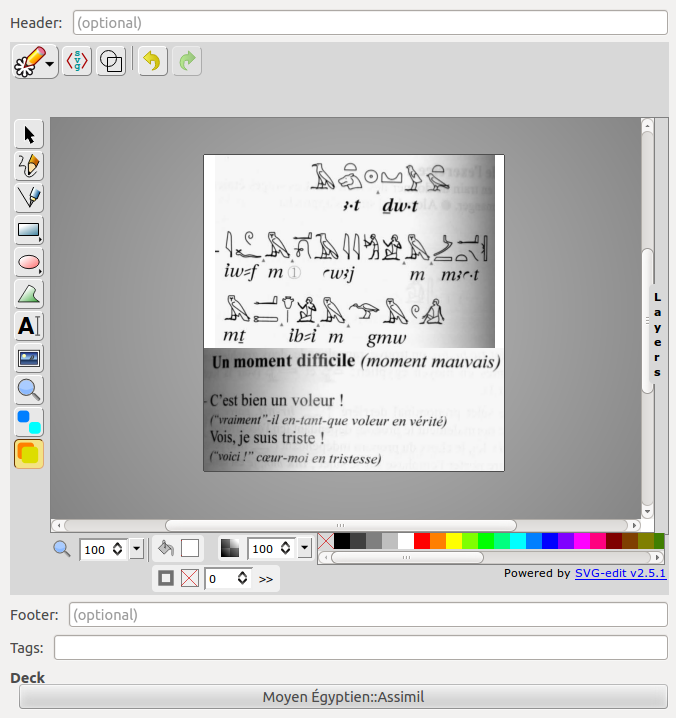
The next step is to block out various unfamiliar parts of the text. Sometimes I block out the transliteration of the hieroglyphs; sometimes I block out half a word on both the hieroglyph and transliteration lines. Basically, I want these occlusions to be ridiculously easy. I’ve found that easy Anki cards work just as well as hard ones, and I can review them a lot quicker, and with a lot more pleasure, so why not? (This technique was inspired by Khatzumoto’s MCD cards.)
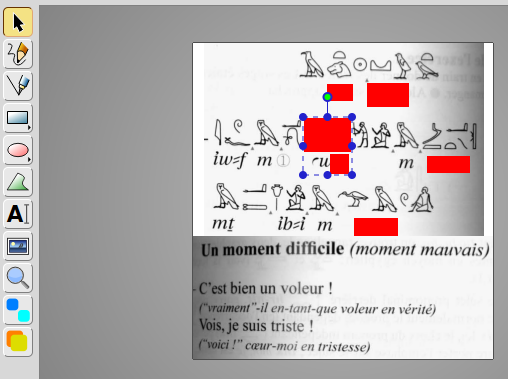
Now, I save the results to Anki (using the overlapping squares button). This will make a separate card for each occlusion. Here’s a preview of the front and the back of one of the resulting cards:
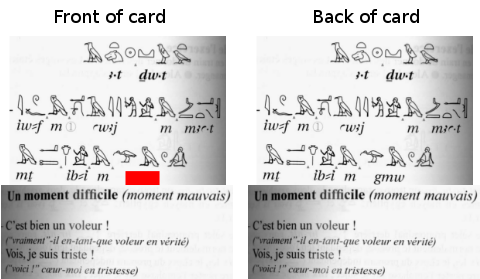
To pass this card, all I need to do is guess what’s under the red bit. One nice thing about this process: I can easily make multiple cards from the same material.
Don’t let Anki turn you into a quivering ball of stress!
Unfortunately, I’ve seen lots of people make themselves thoroughly miserable using spaced repetition software. Here are a few tips that have worked very well for me:
- I spend as little time on data entry as humanly possible. Think “copy and paste”, not “artisinally craft perfect cards.”
- I make multiple, very easy cards from the same material.
- I configure Anki to introduce no more than 5 new cards per day, and my daily reviews rarely go above 10–25 cards. As a rule of thumb, if you introduce X new cards per day, you should be prepared to review at least 5X, and maybe 10X. Give Anki a month of steady use before getting ambitious.
- If a card is hard, boring or annoying, I just delete it. This saves me from endlessly reviewing the same 50 horrible cards. And if I need to know something, I’ll see it again at some point.
- I don’t stress out about the “right” way to cloze things. I try all sorts of different ideas.
As you can see, I’m not using Anki to “permanently memorize” things. I’m using to amplify my natural memory considerably, but I still forget obscure things and delete cards. And that’s OK.
What else could you beemind?
If you’re learning a living language, you’ll face additional challenges. Here are some things which might help you out a lot, and which you could easily beemind:
- Skype conversations per week. If you want to start speaking very early on, Benny Lewis’s book is full of excellent advice. For conversation parteners and tutors, check out iTalki and Verbling.
- Pages read per day. Once you finish an Assimil course, you’ll probably know enough to muddle through real books. Try reading 10 pages a day, and you should see noticeable improvements within a month, and dramatic improvements within a year. Still struggling with real books? Feel free to skim, or to try an ereader with a popup dictionary, or to check out LingQ, Learning with Texts or readlang.
- Episodes of a TV series watched. Once you get good enough to follow 40% of the dialog in a TV series, things get fun. At this point, you should be able to buy a DVD box set of an easy TV series, and start watching. The first episodes may require subtiles and multiple viewings. But within a season or two, you should see dramatic listening gains. TV series are especially good for this, because they have pictures to provide context, and because they have hours and hours of conversations between the same cast members about the same topics, providing much-needed training wheels.
- Words written on lang-8. Try writing 50 or 100 words per day for a month, and getting them corrected by native speakers. This will vastly improve your ability to express yourself.
- Anki cards made using subs2srs. This open source program takes video files and subtitle files, and spits out hundreds of audio flash cards. Just be sure to delete 90% of the cards to preserve your sanity. This will burn dialog into your brain like an annoying top-40 song lyric. Beware: geek skills will be required.
- Your progress on Duolingo. If you’re looking for a fun supplement to a beginner course, Beeminder also has automatic Duolingo integration. I’ve never used Duolingo, but I’ve heard other successful learners recommend it as a fun way to learn vocabulary and master the finer points of prepositions.
Of course, standard beeminding advice applies: Start out minding one or two important goals, with modest targets that you know you can achieve.
Conclusion
I’m having a ton of fun beeminding my Egyptian. Thanks to Anki, I have an unusually good memory. And thanks to Beeminder, I have an unusually good ability to study one lesson per week without that trailing off to zero lessons per week. And that’s one way to learn the basics of an obscure language really slowly, but quite pleasantly, over the course of a couple of years.
Footnotes
[1] Beeminder editor’s note: Eric tried to get us to change “expert” to “enthusiast” but, come on. First of all, have you read this post? Oh, and we didn’t even mention that he also helps moderate a language-learning forum.
[2] On the CEFRL scale, my French is somewhere between B2 and C1. I could take a class in a French university, but I’d struggle a bit.
[3] You can buy a box set of Buffy DVDs from Amazon.fr using your regular Amazon login, password and payment information. You can find a French transcript of the episodes on the web. But be warned: If you want to play DVDs from another country, you’ll probably need a multi-region player.
[4] If you want an excellent introductory-level Egyptian course, but you don’t speak French, check out Middle Egyptian: An Introduction to the Language and Culture of Hieroglyphs by James P. Allen. This is one of the best courses I’ve seen for any language, and it’s quite beginner friendly. If you just want to learn some basic tomb inscriptions, [How to Read Egyptian Hieroglyphs] collier by Collier, et al., is also popular, and I’ve seen some pre-made Anki decks floating around. And if you want a little light reading material, I can’t resist mentioning the British Museum’s Egyptian translation of Peter Rabbit.